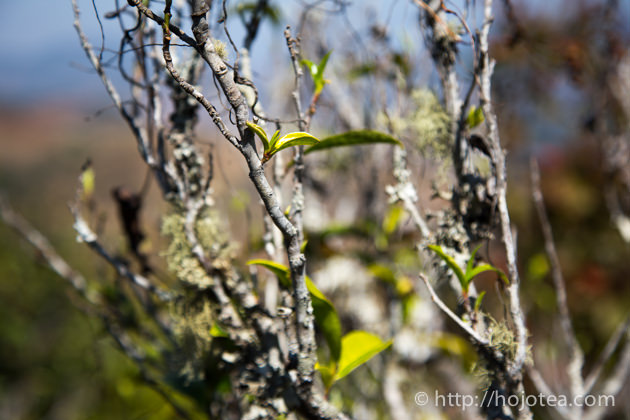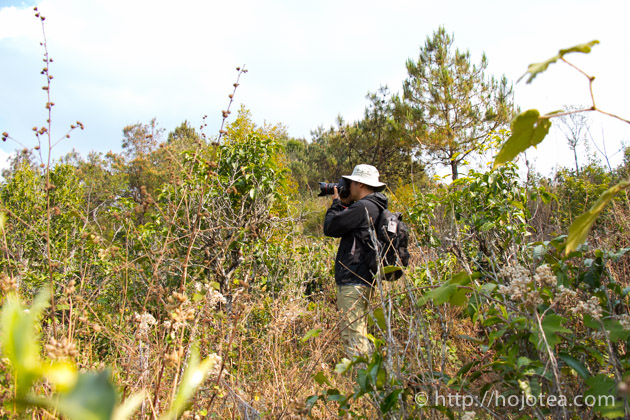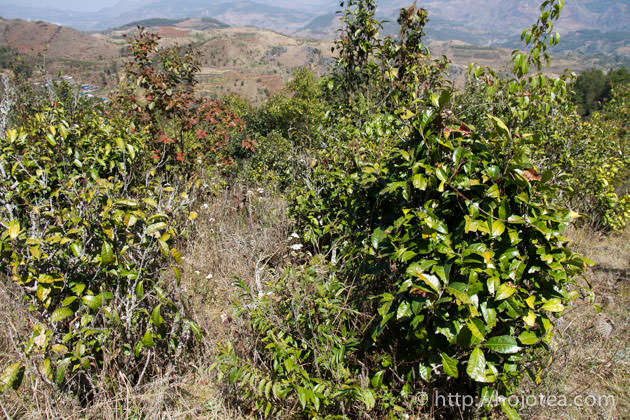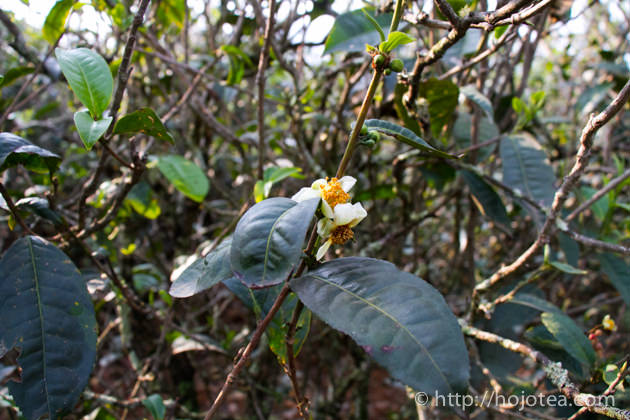- HOME >
- Types of Tea
Producing tea from the White Tea Bush 2017
- [2017.04.16] Posted By Akira Hojo

This year we are planning to produce Bai Shu Raw Pu-erh tea and Bai Shu Black Tea again. If we could manage to produce sufficient quantity of Bai Shu Raw Pu-erh tea, we plan to release the loose tea (mao-cha) on a pre-booking basis. We will then compress the remaining quantity into cake.
In Chinese, Bai Shu means White Bush. We refer Bai Shu as the tea tree grown naturally under the strong sunshine. The trunk of tea tree turns white due to the limited supply of nitrogen from the environment.
https://hojotea.com/en/posts-138/


It looks like wild bush. Actually it is a naturally-farmed tea garden. As all plants co-exist, tea tree is one of nature plants and not the main player.
We visited the tea garden and confirmed the condition
In making Bai Shu tea, it is essential to find the tea garden or tea mountain which turning wild in nature. In recent year, a number of naturally-farmed tea garden is fertilized and the environment is changing. We are very concerned whether or not the natural environment remains the same as last year. So we went up to the mountain to confirm the condition of the tea garden. The tea garden is located in the west of Lincang and the altitude is around 2000m. 


It looks like a dying tree
After checking the condition of the tea garden, I am very relieved. I observed that the tea garden remained natural and healthy. In fact, the tea garden is very messy and there are a lot of weeds. Tea trees are surrounded by many other plants. Some people may think that tea is dying because some branches are really dead. Perhaps if Japanese tea experts look at this situation, they may strongly recommend the use of fertilizers to “salvage” the tea trees.
Throughout my experiments, I came to aware that tea tree is controlling the number of branches and tea leaves according to the nitrogen intake. We often observe the same phenomenon in Japanese tea garden. Some branches of tea tree start dying when fertilizer is not sufficient. In the ecological environment, the tea tree is depending nitrogen on the surrounding ecology. Hence, tea may let dry some branches if less nitrogen is available, but it is nothing but the natural adjustment.




Fresh tealeaf reveals a lot of information
I believe many tea lovers have ever visited some tea gardens. If so, you may have experience of chewing the fresh tea leaf too. What was the taste of the fresh young tea leaf? Usually, at first it gives an astringent and bitter taste, and then followed by the fresh floral scent. In fact, this is the typical taste of tea grown in the fertilized tea garden. If we eat the fresh tea leaf of Bai Shu tea tree, it gives no astringency and no bitterness, and very intense floral scent that linger on our palate for a long time. It reminiscent the wild herbs we plucked in spring. The taste is clear, transparent and the aftertaste is very strong and long-lasting. The difference between fertilized tea and Bai Shu tea is like the different of farmed mushroom and wild mushroom.
The common tea garden in Yunnan
The following photos show tea garden in Yunnan. They use no chemical fertilizer but organic fertilizer is commonly used. The branches are very long, dark brown, and tea leaves in dark green. 


Tea plucking will start this week
Last year tea was sold out very quickly as we could not produce sufficient quantity. Since the weather seems very good in up-coming few days, I am hoping to speed up the collection of fresh leaves and we can produce as much tea as we are wishing.
Related Articles
How to get the latest update on HOJO Tea?
1. Follow Twitter, 2. Click "Like" on Facebook, and 3. Subscribe in newsletter. You can have the latest tea news from HOJO Tea.
 Subscribe the Newsletter to enjoy the privileges
Subscribe the Newsletter to enjoy the privileges- You may receive a free sample upon purchase, or you may have the priority to purchase special products. So please remember to subscribe our newsletter as well as the social network.
- New Release of High Mountain White Tea
- We are pleased to introduce our High Mountain White Tea, sourced from a unique tea garden with two key features: 1. Located at an altitude of 2200-2300m2. Completely wild and untended The ideal natural conditions of this garden result in tea of exceptional quality, offering a pure and gentle, nourishing taste. High Altitude and Wild …
- New Release of Da Xue Shan Wild White Tea 2024
- We have released the 2024 Da Xue Shan Wild White Tea Loose Leaf. This tea was produced under our direct supervision during our stay in Yunnan Province, ensuring meticulous production management on site. Definition of Wild Tea in Yunnan Province People in Yunnan strongly associate Camellia taliensis with wild tea, regardless of where it is …
NEW ARTICLES
 Why Do Some Teas Taste Astringent? Exploring the Causes and Mechanisms of Astringency
Why Do Some Teas Taste Astringent? Exploring the Causes and Mechanisms of Astringency- Tea can range from having no noticeable astringency to possessing a very strong one. What causes this astringency? This article explores the causes and mechanisms behind astringency in tea. Causes of Astringency Astringency arises from the binding of tea components to proteins in the oral cavity, creating a sensation of tightness or dryness. The tongue …
 The Impact of Heat Sources on Tea Flavor
The Impact of Heat Sources on Tea Flavor- It is widely recognized that the material of a kettle plays an important role in shaping the taste of water for brewing tea. Yet, an often overlooked but equally significant factor is the type of heat source used to boil the water. Different heat sources, whether gas, electric, charcoal, or wood fire, can impart distinct …
 New Release of High Mountain White Tea
New Release of High Mountain White Tea- We are pleased to introduce our High Mountain White Tea, sourced from a unique tea garden with two key features: 1. Located at an altitude of 2200-2300m2. Completely wild and untended The ideal natural conditions of this garden result in tea of exceptional quality, offering a pure and gentle, nourishing taste. High Altitude and Wild …
 New Release of Da Xue Shan Wild White Tea 2024
New Release of Da Xue Shan Wild White Tea 2024- We have released the 2024 Da Xue Shan Wild White Tea Loose Leaf. This tea was produced under our direct supervision during our stay in Yunnan Province, ensuring meticulous production management on site. Definition of Wild Tea in Yunnan Province People in Yunnan strongly associate Camellia taliensis with wild tea, regardless of where it is …
 New Release of Wild Pu-erh Jasmine Pearl
New Release of Wild Pu-erh Jasmine Pearl- Out of curiosity, we decided to create a jasmine tea based on Da Xue Shan Wild Raw Tea. This resulted in an exceptionally rare tea, not only in Japan but also in China. Custom Production Network for Jasmine Tea At our store, we source various types of base teas from different regions during the spring. …
 2024 Overview: Our Yunnan White Tea Quality, Process, and Weather Insights
2024 Overview: Our Yunnan White Tea Quality, Process, and Weather Insights- One of the teas we’ve been focusing on in Yunnan Province is white tea. Historically white tea has been produced in both Fujian Province and Yunnan Province for a long time. While white tea from Fujian Province is well-managed during processing, we are dissatisfied with the quality of the raw materials due to the use …
 Yunnan’s Hospitality Culture: Expressed Through Meals
Yunnan’s Hospitality Culture: Expressed Through Meals- In China, as a form of greeting, it’s common to say “你吃饭了吗?” which means “Have you eaten?” However, in Yunnan Province, the phrase “吃饭” is often used in various situations, more like “Eat, eat,” serving as an invitation to share a meal. Yet, with prolonged exposure to Yunnan, one comes to understand that these meal …
 In Search of Wild Tea: Exploring Mountain Villages in Southwest Lincang, Yunnan
In Search of Wild Tea: Exploring Mountain Villages in Southwest Lincang, Yunnan- We are currently sourcing tea in the southwestern part of Lincang City, Yunnan Province. One of the crucial products for us is wild tea. While tea processing is important, securing the raw materials poses the biggest challenge. Recently, we received information about a new location where wild tea supposedly grows. To verify this, we visited …
 New Release of Anxi Traditional Oolong
New Release of Anxi Traditional Oolong- Anxi, located in Fujian province, China, is celebrated for its Tie Guan Yin tea. However, the Traditional Anxi Oolong from this region boasts a unique fruity aroma, distinguishing it from Tie Guan Yin. Anxi: A Renowned Hub for Oolong Tea Production in China Fujian Province, renowned for its rich tea heritage, boasts several prominent tea-producing …
 Yunnan 2024 Spring Tea Sourcing
Yunnan 2024 Spring Tea Sourcing- Yunnan Province is globally renowned for the exceptional quality of its tea leaves. However, lax production management often presents challenges in achieving the desired tea quality when relying solely on pre-made teas. To address this issue, we have committed to remaining on-site throughout the spring season to closely monitor tea production. We are meticulously inspecting …
Shop Info

Address:Lot No. T-215, 3rd Floor, The Gardens Mall, Mid Valley City, Lingkaran Syed Putra, 59200 Kuala Lumpur
Tel: +603-2287-4537
Business Hour: 10am to 10pm
Category
- New Arrival at HOJO Online Shop
- Featured Articles
- Newsletter
- Types of Tea
- Origin of Tea
- Teapot and Tea Equipment
- Tea Column
- How to enjoy tea
- Tea Processing
- How to choose quality tea
- Tea constituents and functional effect
- Safety of Tea
- Foods
- Tea Business Operation
- Hobby and Outdoor Activity
- Ranking of Tea
- Video
- FAQ
- Media Release
Profile

- AKIRA HOJO
- I invite you to experience my tea selections.I was born in Nagano, Japan. In university, I studied agricultural chemistry, and I have the master degree in food science. I worked in Japanese food industry for 10 years. I involved in R&D, QC and QA. As a factory manager, I implemented ISO9000 series and managed the factory.
- The Art of Tea Magazine
- We posted the article on “The Art of Tea Magazine No.9, the magazine is published in Taiwan. We featured some scientific view about the tetsubin
- New Straits Times
- The Malaysian National Newspaper, New Straits Times featured HOJO Tea on 17-Oct-2007.















